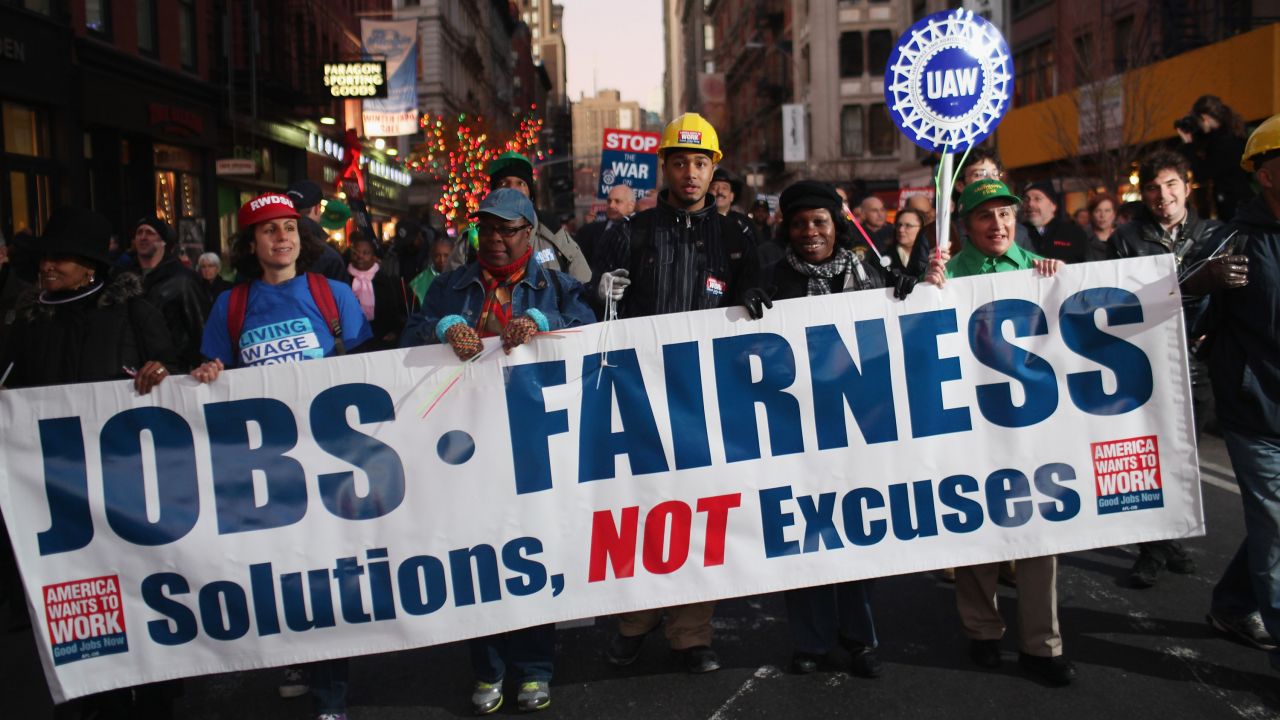
Members of area labor unions and Occupy Wall Street demonstrators participate in a "March For Jobs and Fairness" on Dec. 1, 2011 in New York City. Thousands attended the late afternoon rally which included members of over 300 New York City and tri-state unions. Demonstrators called for jobs and an end to the nation's growing economic disparity. (Photo by Spencer Platt/Getty Images)
This post originally appeared at Truthout.
Donald Trump’s well-publicized deal with the Carrier Corporation last fall was “wildly popular” with US voters, according to Politico. A survey by Politico/Morning Consult on Dec. 1-2, 2016, found 60 percent of respondents viewing Trump more favorably because of the Nov. 30 agreement, which the real estate mogul claimed would save 1,100 jobs that the air-conditioner manufacturer had been planning to move from Indiana to a facility in Mexico.
As so often is the case, reality didn’t match up with the president’s assertions. The actual number of jobs saved turned out to be more like 730, and the deal involved a $7 million tax break for Carrier, a brand of United Technologies Corporation. Chuck Jones, the president of the Steelworkers local at the affected plant, told The Washington Post that Trump “lied his ass off.” More recent claims that Trump has already started saving US jobs are equally questionable. But Trump’s duplicity is nothing new; there’s a more important problem with the popularity of Trump’s Carrier deal. The focus on trade and offshored jobs is distracting us from the main issue: the jobs we still have.
It’s true that we need to stanch the flow of manufacturing jobs out of the country. Vermont Sen. Bernie Sanders is proposing a sensible plan for this, and of course, we have to put an end to the misnamed “free trade” agreements, with a special focus on solidarity with the super-exploited workers who now hold the jobs these trade deals have encouraged US companies to send abroad. Still, all this is basically just closing the barn door. The jobs that can be outsourced most easily have long since bolted.
Remembering the “Satanic Mills”
A huge range of goods on the US market — textiles, for example, apparel and electronics — are now produced in other countries. The Carrier Corporation may go on building some air conditioners in Indiana, but the fact remains that about 80 percent of the world’s air conditioners come from China. And despite media stories about a US “manufacturing renaissance,” there’s no indication that the jobs are coming back any time soon, according to a 2015 study by the Information Technology and Innovation Foundation (ITIF).
As of 2014, manufacturing accounted for just 8.1 percent of the jobs in the United States; the service sector’s share was an overwhelming 80.1 percent. That’s the reality — but is it a problem?
From what we hear and see in the mainstream media, we might think manufacturing jobs have some intrinsic quality ensuring good pay and decent working conditions. Apparently, no one remembers the actual situation during the 19th and early 20th centuries: the low pay, the long hours, the routine workplace accidents, the exploitation of child labor. There was a reason factories were regularly described as William Blake’s “dark satanic mills.” But we don’t need to go back to the history books; we can just look at manufacturing right now in the Global South. Many of the 1,134 Bangladeshi workers who died in the 2013 Rana Plaza collapse were working at jobs that had been offshored from Europe and the United States.
If we think of manufacturing as a source of good jobs now, it’s only because working people made it that way — angry, militant working people who united to fight the bosses and the politicians. Actions like the 1909-10 Uprising of the 20,000 in New York City were what raised wages and helped end child labor in the garment industry, while mass walkouts, such as the 1912 Lawrence Textile Strike did much to make the lives of textile workers more bearable. If people want to hold on to jobs in heavy industry today, it’s only because of the great mass strikes of 1934 and the plant occupations of 1936 and 1937. As FiveThirtyEight’s Ben Casselman noted last spring, US workers don’t miss manufacturing jobs; they miss the benefits of unionization.
In other words, if we’re faced with a service economy, we need to concentrate on fighting for better service jobs. Our priority now has to be efforts like OUR Walmart and Fight for $15.
The Return of the Sit-Down Strike?
These campaigns have already helped raise wages for millions of US workers, but they haven’t resulted in the sort of labor organizing that marked the 1930s.
There are various reasons: It’s more difficult to organize workers when they are dispersed in small shops and franchises than when they’re crowded together in a large industrial plant; unionization drives now run up against a series of anti-labor laws and court decisions; and too much of the current labor leadership tends to be cautious and unimaginative. But the climate was far more anti-labor a century ago; back then even peaceful picketing was often met with injunctions and nightsticks. As for the union leadership, it’s hard to imagine bureaucrats more hidebound than the gentlemen who headed the old American Federation of Labor at the start of the 1930s. And people forget that the garment shops of the early 1900s were small and scattered, and yet workers managed to organize — without tools like the internet.
In fact, the biggest impediment to service sector organizing today is just that we have been viewing it as some separate campaign off in a corner of the labor movement. We need to recognize that it’s a crucial element in the broad struggle for social and economic justice.
The potential is certainly there. We can see it in the support for Sanders’ 2016 campaign from a highly diverse youth population, which happens to make up a large part of the service economy’s workforce. Many older white workers will be supportive as well, including some who backed Trump in the election: they’re bound to have a serious case of buyer’s remorse if they find themselves facing Trump’s designated labor secretary, fast-food CEO Andrew Puzder.
History never repeats itself exactly. The sit-down strikes of the Great Depression may not be coming back, but we can learn to emulate our predecessors’ boldness and determination. If we do, we’ll be building a movement with far more right to be “wildly popular” than any publicity stunt from the reality-show president.
Copyright, Truthout.org. Reprinted with permission




